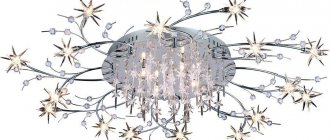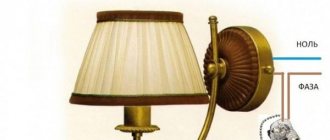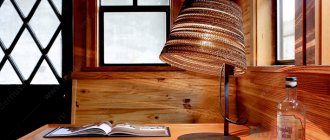Principle of operation
The operating principle of a traditional chandelier is simple: using a stationary switch, power is supplied to the device. The lights on the control panel are a little more complicated. In appearance, they are no different from ordinary ones.
A signal-receiving element is built into their design, which is skillfully camouflaged and therefore not noticeable. The remote control allows you to turn the light on/off and adjust its brightness from a long distance - from 30 to 100 m.
The lighting circuit on the remote control often includes halogen lamps and LEDs, which makes energy consumption economical.
Room dependent
Of course, when buying a chandelier, we always think about where exactly to hang it. The purpose of the room where the lamp is required determines the size of the device, its color and lighting power.
- The hall requires a chandelier with bright and warm light to fill the room with coziness. For high ceilings, a formal pendant chandelier is acceptable; in a classic interior it can be crystal. A hall that is standard in size and shape is most often decorated with a ceiling lamp with shades (no more than 6 pieces). If you need harmonious lighting for a long room, buy small ceiling fixtures and place them symmetrically at the top. In all cases, do not forget about the ability to adjust the lighting using a dimmer.
- The bedroom is always a place of relaxation. In such a situation, the chandelier should complement the interior and not get lost, but at the same time be conducive to relaxation. A product with a lampshade looks best, and it also provides a pleasant, subdued light. A good chandelier for a bedroom is made of frosted glass or crystal, painted in pleasant undertones and has several operating modes. It is also convenient to buy a lamp with a remote control. If you do not want to remove dust from the device almost every day, when answering the question of how to choose a chandelier for the bedroom, give preference to models with a minimum of crystal pendants and a fairly compact size.
- A playful and ornate chandelier is worth buying for a child’s room. This is where this accessory should maintain an atmosphere of fun. However, you should never forget about safety, so avoid models made of crystal or thin glass. It is best to choose plastic or textile lampshades. At the same time, ceiling chandeliers are preferable to pendant ones. Determining the right color should be left to the child.
- The hallway needs a chandelier of longitudinal shapes so that the narrow corridor is illuminated evenly. It is desirable that the streams of light are directed not at the mirrors, but at the person himself. Therefore, it is worth purchasing models with rotating spots that change the angle of illumination. Most often, a strict and modest lamp is chosen for the corridor.
- A common problem is the lighting fixture in the kitchen. First you need to correctly decide on the materials of the chandelier. High humidity and drops of grease pose a danger to textile shades, so metal or glass would be preferable. If the kitchen has low ceilings, you can safely hang a round ceiling fixture there. Wooden lamps are permissible only when coated with varnish or paint. A chandelier with forged fragments must have a top layer of mastic to protect it from dirt. In addition to aesthetic functions, a kitchen lamp also has a lot of tasks related to the distribution of light flux. Therefore, it is better to choose models with different modes and well-regulated power. For a narrow kitchen, you should prefer an elongated chandelier or a group of small lamps. A large hanging model would look appropriate in a large room. It is also worth remembering that the kitchen will most likely need combined lighting, i.e. additional devices are needed. As a rule, they are allocated to the dining area, stove and cabinets.
Types of chandeliers
Buyers are offered a large number of models of lighting fixtures: pompous and discreet, massive and compact, monochrome and colorful.
Based on the type of construction, they are divided into suspended and ceiling-mounted. Hanging chandeliers are attached to a hook installed in the ceiling using a chain or string. The junction of the wires with the wiring and the elements with the hook is masked with a decorative plate.
The length of the cord differs for different models; usually, it can be adjusted at the request of the owners. They are made from different materials: metal and textiles, crystal and glass, wood and paper, etc. They are made in different styles and forms.
Suspended models can be single-shade or have a frame to which lamps are attached. An interesting option is with clusters of 5-6 lampshades suspended from the base on cords.
If the lengths of these strings are the same, then a classic light composition is obtained. Various-sized pendants create fancy multi-level art objects.
Pendant lamps differ in the orientation of the shades. The preferred option is when the lamps “look” up - this position provides light dispersion that is comfortable for the eyes.
If the ceiling surface has a mirror-like gloss, it is better to choose a device with downward-facing shades. An alternative idea is to purchase a chandelier with adjustable spotlights that can be easily turned to the sides.
Another type of design is a surface-mounted light fixture attached to the ceiling using a strip. This is an option for rooms with low ceilings.
More often such products are made in the form of a plate. They can be multi-segmented or a one-piece structure. The lamp shades of this type of lighting fixtures are usually made of glass or plastic. The more transparent the material, the more light the device transmits.
To enhance the lighting function, models are equipped with mirror reflectors. Under the lampshade there is one or more lighting sources. The disadvantage of ceiling lamps is that to replace a burnt out light bulb you have to remove the ceiling lamp.
According to their style, chandeliers are divided into:
A variation of this type is crystal chandeliers, the decor of which is made of crystal. The material enhances the light from lamps and creates mesmerizing shimmers.
Hanging chandelier: a veteran among lamps
The first prototype of a pendant lighting device appeared in the 12th century. The product was a ceiling beam on which copper bowls were attached. They were filled with flammable substances: oil or fat. Later, candles began to be installed around the perimeter of the bowls, and after the invention of electricity, light bulbs. Chandeliers in cathedrals and temples have retained the appearance of their medieval ancestors.
Design and fastening features
A pendant chandelier consists of one or more lampshades and a suspension for their installation. A hanger is a chain or string through which electrical cords pass to the sockets. At its end on the ceiling side there is a cup-shaped decorative element. It masks the junction of the wires.
Recently, it has become fashionable to decorate a home with pendant chandeliers without lampshades.
The chandelier is attached to a metal hook. It is usually installed during the construction of an apartment. If you are making repairs and the hook is already installed, check it for strength. This will prevent the chandelier from suddenly collapsing. Hang a weight on it corresponding to the weight of the future lamp and leave it for several days. If the hook bends or falls out, the fastening must be replaced.
You can shorten the light fixture by removing chain links or cutting the string. When choosing the length of the suspension, follow the rule: there should be a distance of 2-2.5 m between the lower part of the lamp and the floor. If it is larger, the product will look high and lonely, less - it will interfere, it will be touched by your head or hands.
Types of hanging chandeliers
We will not describe the design features of the devices. There are a huge number of them and it’s easier to see them in a store or in a catalog. But let’s focus on the typology depending on the design. This parameter is directly related to the lighting capabilities of the product.
- Single
The model has one lamp. It is convenient for zoning a room or in the kitchen, where you need to illuminate the dining table. The design can be varied: a decorative socket without a lampshade, with a textile or plastic shade, or an LED solution.
- Doubles
or
triple
hanging lampshades on a rod are also convenient for illuminating a single area or small room. - Classical three
- and
five-arm
options allow you to distribute the light evenly. - Multi-tiered
the devices provide the brightest lighting possible, but are harmoniously combined only with complex interiors, where there are a lot of decorative details.
Characteristics of chandeliers
The main characteristic is power. This parameter even affects the appearance of lighting fixtures. The indicator consists of the power of the lamps on the chandelier. The more shades a chandelier has, the more powerful it is.
The recommended option is 15-25 W per 1m2 room.
The choice of a lamp suitable for a chandelier is important:
The products burn out quickly, and their ability to get very hot makes them unsuitable for textile and paper lampshades;
Another characteristic of lamps is material. More often, lampshades and shades are made of plastic, durable glass, crystal, textiles, and paper.
The frame is usually made of metal, wood or plastic. Sometimes completely unexpected materials are used as decoration - feathers, dried berries, etc.
Ceiling chandeliers in the interior of small apartments
According to building codes, ceiling height ranges from 2.5 m in Khrushchev and new buildings to 3.2 m in luxury housing. However, the lower limit is often reduced as a result of leveling the surface or installing tension strips. In such rooms, long lamps are inappropriate: they “eat up” space and look bulky. The optimal solution is ceiling chandeliers. They are minimalistic and fit harmoniously into small apartments.
Design and installation
The product package includes a fastening strip and a part decorating the mounting location. Lampshades come out of it. Light sources can be mounted directly into the device.
The fastening strip is fixed to the ceiling using self-tapping screws or self-tapping screws and is masked with a tightly fitting element resembling a plate. All this is secured with retaining nuts, then lampshades and other components are installed.
If you are replacing a pendant chandelier with a ceiling one, do not cut it, but bend the hook. You may find it useful during your next renovation.
To increase the lighting capacity of the product, manufacturers supplement it with a reflector that scatters the light.
Types of ceiling chandeliers
The design imposes restrictions on the variety of assortments. Therefore, the main typology concerns style decisions
: the market offers classic and vintage designs, Japanese-style options, high-tech, etc.
Models differ in the number of lamps. But the more there are, the less their power. For example, for a sample with 10 cartridges, the light bulb power is only 20 W. Even with a large number of cartridges, the room area in which a ceiling device can be installed is limited.
We talked about installing pendant and ceiling chandeliers to a concrete ceiling. You can do this yourself. If you have a tensioned or plasterboard surface, installation becomes more complicated, and we recommend turning to professionals. It is impossible to install the lamp without special tools and additional parts that will strengthen the suspension location.
pros
In modern apartments you will no longer see a dim Ilyich light bulb hanging alone from the ceiling. Lighting devices ennoble the interior and create lighting suitable for the room of the appropriate purpose.
In the bedroom, a soft and cozy light is desirable, conducive to rest and relaxation; in the living room, when receiving guests, it is bright and festive; in the nursery, it is powerful, but at the same time comfortable for the eyes.
Advantages of different chandelier light options:
A chandelier is also a means of creating the right atmosphere.
Chandelier dimensions
When choosing the size of a chandelier for the living room, you should take into account the size of the room, the style of the interior, the number of windows in the room, the number and size of furniture.
The chandelier should provide enough illumination without looking out of place in the room.
- If you have low ceilings in your living room and the room itself is not very large, you should not use bulky chandeliers with long pendants; it is better to choose a medium-sized ceiling chandelier.
- A large chandelier in a small room will visually make this room even smaller. Therefore, in this case, it is recommended to take a closer look at smaller options.
In a large, spacious living room, a large chandelier will be much more suitable. If the size of the room allows, then you can generally use huge chandeliers, but provided that they are appropriate and look beautiful.
Under no circumstances should the chandelier interfere with you or cause discomfort. On the contrary, it was created in order to give light and improve the mood of others.
Which is better
Features of an “ideal” lamp:
The model must correspond to the style and functional features of the room it will illuminate. The direct purpose of the lighting device is to provide the correct light.
Therefore, the best chandelier in each case is the one that has sufficient power and gives the desired shade of radiance.
For example, a relaxing bluish glow is appropriate in the bedroom, but a lamp of this shade in the kitchen will give an unappetizing blue color to the food. For this place, the best option is an orange lampshade.
Exploitation
Operating the chandeliers is simple and safe. Traditional models are controlled using switch buttons.
The options on the remote control are controlled from a long distance (you can also use a switch if desired). The remote control requires periodic battery replacement.
During use, the product becomes dirty. It needs to be cleaned at least once every three months. To thoroughly wash the surface lamp, it will have to be removed.
For hanging models, simply unscrew the shades and wipe the frame itself with a damp cloth, paying attention to decorative curves and recesses.
Terminology of lamps (our Wikipedia).
Due to the wide range of different lamps, it is easy to get confused in the existing terms. Some people are confused by the names for lamps for different purposes. These include sconces, floor lamps, hanging and ceiling chandeliers, etc. To make it easier to understand, we will try to make a description and give specific examples:
The lamp consists of: - electrical part (wires, sockets, terminal block, transformers, chandelier control unit, LEDs, etc.) - base (structural part of the lamp, which is attached to the surface of the ceiling, wall or serves as a support for the entire lamp). — frame (the main element of the lamp on which electrical and decorative elements are mounted. It may be absent in pendant or recessed lamps or be integral with the base). — a lampshade (an element of a lamp that covers a light bulb. It serves to diffuse or direct the light flux, and is a decorative component of the lamp. Most often made of glass or plastic.










